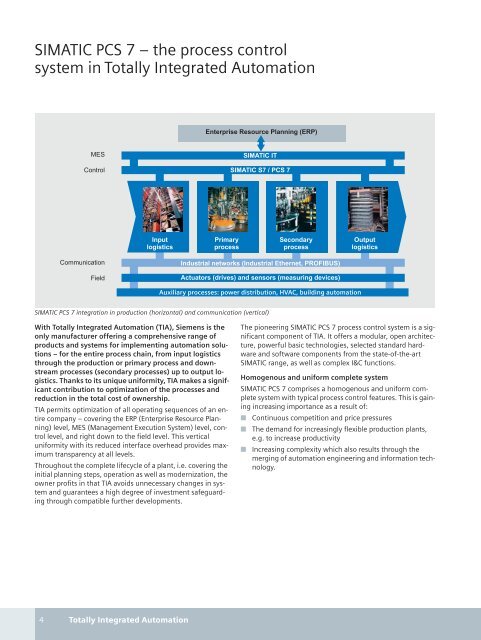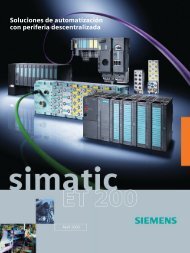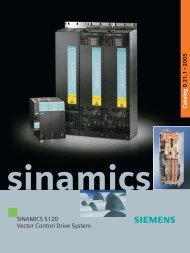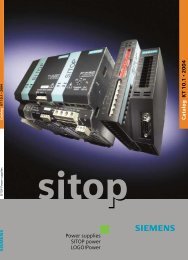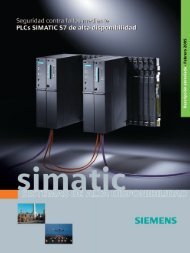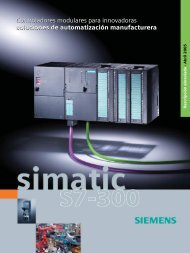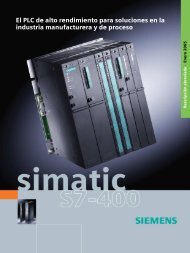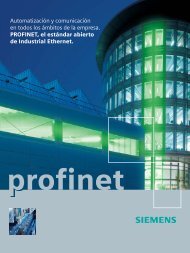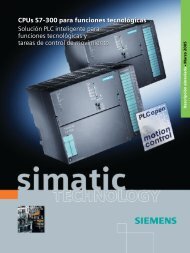SIMATIC PCS 7 process control system
SIMATIC PCS 7 process control system
SIMATIC PCS 7 process control system
You also want an ePaper? Increase the reach of your titles
YUMPU automatically turns print PDFs into web optimized ePapers that Google loves.
<strong>SIMATIC</strong> <strong>PCS</strong> 7 – the <strong>process</strong> <strong>control</strong><br />
<strong>system</strong> in Totally Integrated Automation<br />
Enterprise Resource Planning (ERP)<br />
MES<br />
Control<br />
<strong>SIMATIC</strong> IT<br />
<strong>SIMATIC</strong> S7 / <strong>PCS</strong> 7<br />
Input<br />
logistics<br />
Primary<br />
<strong>process</strong><br />
Secondary<br />
<strong>process</strong><br />
Output<br />
logistics<br />
Communication<br />
Field<br />
Industrial networks (Industrial Ethernet, PROFIBUS)<br />
Actuators (drives) and sensors (measuring devices)<br />
Auxiliary <strong>process</strong>es: power distribution, HVAC, building automation<br />
<strong>SIMATIC</strong> <strong>PCS</strong> 7 integration in production (horizontal) and communication (vertical)<br />
With Totally Integrated Automation (TIA), Siemens is the<br />
only manufacturer offering a comprehensive range of<br />
products and <strong>system</strong>s for implementing automation solutions<br />
– for the entire <strong>process</strong> chain, from input logistics<br />
through the production or primary <strong>process</strong> and downstream<br />
<strong>process</strong>es (secondary <strong>process</strong>es) up to output logistics.<br />
Thanks to its unique uniformity, TIA makes a significant<br />
contribution to optimization of the <strong>process</strong>es and<br />
reduction in the total cost of ownership.<br />
TIA permits optimization of all operating sequences of an entire<br />
company – covering the ERP (Enterprise Resource Planning)<br />
level, MES (Management Execution System) level, <strong>control</strong><br />
level, and right down to the field level. This vertical<br />
uniformity with its reduced interface overhead provides maximum<br />
transparency at all levels.<br />
Throughout the complete lifecycle of a plant, i.e. covering the<br />
initial planning steps, operation as well as modernization, the<br />
owner profits in that TIA avoids unnecessary changes in <strong>system</strong><br />
and guarantees a high degree of investment safeguarding<br />
through compatible further developments.<br />
The pioneering <strong>SIMATIC</strong> <strong>PCS</strong> 7 <strong>process</strong> <strong>control</strong> <strong>system</strong> is a significant<br />
component of TIA. It offers a modular, open architecture,<br />
powerful basic technologies, selected standard hardware<br />
and software components from the state-of-the-art<br />
<strong>SIMATIC</strong> range, as well as complex I&C functions.<br />
Homogenous and uniform complete <strong>system</strong><br />
<strong>SIMATIC</strong> <strong>PCS</strong> 7 comprises a homogenous and uniform complete<br />
<strong>system</strong> with typical <strong>process</strong> <strong>control</strong> features. This is gaining<br />
increasing importance as a result of:<br />
■ Continuous competition and price pressures<br />
■ The demand for increasingly flexible production plants,<br />
e.g. to increase productivity<br />
■ Increasing complexity which also results through the<br />
merging of automation engineering and information technology.<br />
4 Totally Integrated Automation


